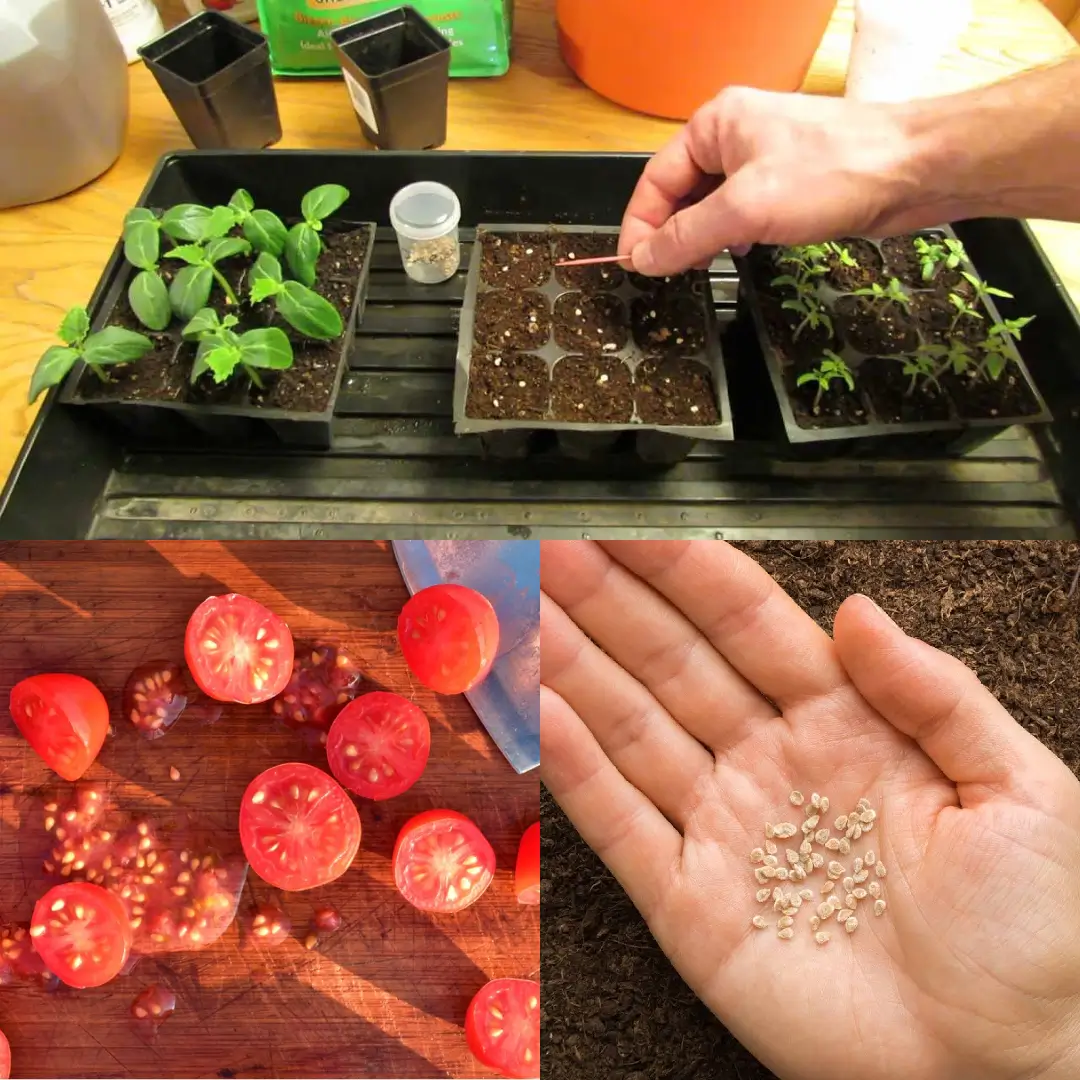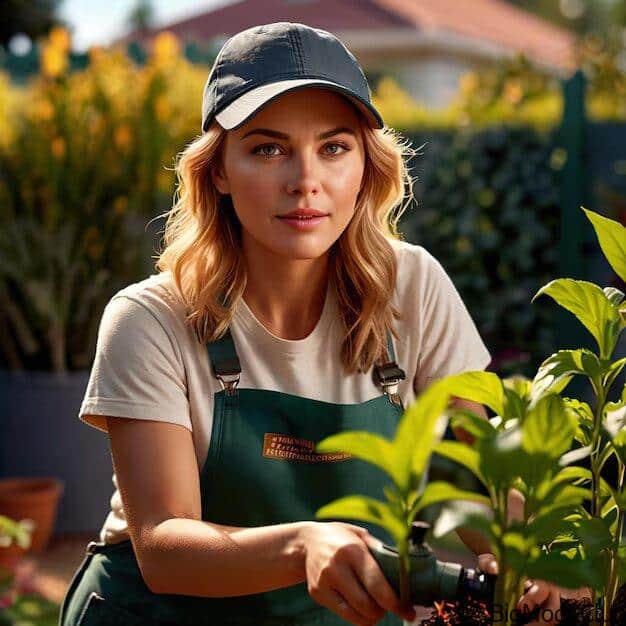If you’re eager to plant tomato seeds and grow your own tomatoes, understanding the different types of tomato plants is the first step. Tomato varieties are classified by their fruit size, shape, or growth habits. In this guide, we’ll focus on determinate (bush) and indeterminate (vining) varieties. Determinate plants grow as compact bushes and don’t require much pruning, while indeterminate plants grow as climbing vines that need pruning and staking. Ready to get started? Let’s dive into how to plant tomato seeds and grow your very own fruitful garden!
Why Grow Tomatoes from Seeds?
Before we jump into the process, let’s take a moment to appreciate the magic of growing your own tomatoes. Sure, you could buy seedlings from a nursery, but there’s something special about starting from scratch. When you grow tomato seeds, you get to choose from an incredible variety of tomatoes, from juicy beefsteaks to sweet cherry varieties. Plus, growing from seed is more economical and gives you a head start on the growing season.
Did I mention it’s also super fun? Imagine the satisfaction of biting into a homegrown tomato, knowing you nurtured it from a tiny seed.
Preparing to Plant Tomato Seeds
Selecting the Right Tomato Variety
First things first, pick the tomato variety that suits your gardening goals. Do you want tomatoes for sauces, slicing, or snacking? Tomatoes come in determinate (bushy) and indeterminate (vining) varieties. Determinate tomatoes grow as compact bushes and require less maintenance, while indeterminate varieties need staking but keep producing fruit all season long.
Understanding When to Start Sowing Tomato Seeds
Tomatoes are warm-weather crops, so timing is crucial. In temperate climates, the best time to plant tomato seeds is around 6-8 weeks before the last expected frost. This gives the seedlings plenty of time to grow strong before being transplanted outdoors. If you’re in a tropical or subtropical climate, you can start your seeds at almost any time of year. Just make sure the soil is warm and the frost has passed.
How to Sow Tomato Seeds
Alright, let’s get to the fun part—sowing those seeds! Whether you’re sowing directly into your garden or starting seedlings indoors, the process is relatively simple.
Direct Sowing into the Garden
Want to keep things simple? You can plant tomato seeds directly into your garden soil, but this is best suited for gardeners in warmer climates where frost isn’t a concern.
- Depth and Spacing: Sow your seeds about 5mm deep, keeping them 50cm apart in rows that are 60-70cm apart. This gives your plants enough space to grow and flourish.
- Soil: The soil should be rich, well-draining, and full of organic matter. Keeping it moist but not wet is key here. Think of it like keeping a sponge damp—not soaked.
- Temperature: Tomato seeds need warmth to germinate, so the ideal soil temperature should be between 21-27°C. If the soil is too cold, the seeds may take longer to sprout or not germinate at all.
- Germination: In 5-10 days, you’ll start seeing tiny green shoots pop up. This is always the most exciting part!
Raising Seedlings Indoors
If you live in a cooler climate, or you simply want a jump start on the growing season, you can start your seeds indoors. Growing seedlings indoors gives you more control over conditions, ensuring a higher success rate.
- Containers: Fill trays, punnets, or jiffy pots with a high-quality seed-raising mix. You can also use soil starter pellets for an easier cleanup.
- Depth: Sow your tomato seeds 5mm deep, just like with direct sowing.
- Moisture: Keep the soil moist but not waterlogged. Use a spray bottle to mist the soil if necessary.
- Germination: At the ideal temperature (again, 21-27°C), your seeds should sprout within 5-10 days.
- Light: Place your trays in a warm spot with plenty of natural light, such as a sunny windowsill. If that’s not available, grow lights can do the trick. Your seedlings will need about 6-8 hours of sunlight each day.
Transplanting Tomato Seedlings
Once your seedlings have grown their first true leaves and are around 5-10cm tall, it’s time to transplant them into the garden. This is a critical stage in learning how to plant tomato seeds, as transplanting too early can stunt their growth.
Hardening Off Seedlings
Before you move your seedlings outdoors, they need to acclimate to the new environment. This process is called hardening off, and it involves gradually exposing your seedlings to outdoor conditions. Start by placing them outside for a few hours a day in a sheltered spot, slowly increasing their time outdoors over a week or so.
Planting Out
Now, onto the garden they go!
- Spacing: Transplant seedlings 50cm apart with rows 60-70cm apart to give them room to spread.
- Soil Preparation: Make sure your soil is well-draining and enriched with compost or aged manure. Tomatoes are heavy feeders, so a nutrient-rich soil base is essential for a bountiful harvest.
- Planting Depth: When transplanting, bury the seedlings deep, up to their first set of leaves. Tomatoes can grow roots along their buried stems, which helps them establish a strong root system.
Protecting Seedlings from Frost
Tomatoes are frost-sensitive, so wait until all danger of frost has passed before planting outdoors. If you’re uncertain about frost, keep some row covers or frost blankets handy just in case temperatures dip unexpectedly.
Caring for Your Tomato Plants
Congratulations! You’ve successfully planted your tomato seeds and transplanted the seedlings into your garden. Now comes the care and maintenance stage to ensure your plants grow healthy and strong.
Watering Tomato Plants
Tomatoes love consistent watering, but they don’t like wet feet. Water the plants deeply, ensuring the moisture reaches their roots. The key is to water when the soil feels dry about 5cm below the surface. Water early in the morning or late afternoon to avoid evaporation and to keep the plants hydrated through the heat of the day.
Fertilizing for Strong Growth
If you’ve prepared your soil well, you may not need extra fertilizer. But, for an extra boost, apply a slow-release fertilizer when transplanting or use a balanced fertilizer during the flowering and fruiting stages. This encourages healthy growth and an abundant harvest.
Common Problems and How to Fix Them
Like any plant, tomatoes come with their own set of challenges. Here’s a quick rundown of the most common issues and how to tackle them.
Aphids
Aphids are small, sap-sucking insects that can stunt your plant’s growth. To manage them, try spraying with a hose or use a homemade soap spray. You can also introduce natural predators like ladybugs to control the population.
Blossom End Rot
Blossom end rot is caused by a calcium deficiency and inconsistent watering. Ensure your plants are watered evenly and consider adding a calcium supplement to the soil.
Split Fruit
Overwatering or heavy rainfall can cause tomato skins to split. To prevent this, mulch your plants and water consistently.
Harvesting Your Tomatoes
Finally, the moment you’ve been waiting for—harvest time!
When to Harvest
Tomatoes are ready to harvest about 60-100 days after planting. You’ll know they’re ripe when they change color and give slightly when gently squeezed. Regular harvesting encourages the plant to produce more fruit, so don’t wait too long!
How to Harvest
To harvest, twist the tomato from the vine or use garden shears to snip them off. Store your tomatoes at room temperature if you plan to eat them soon, or refrigerate for longer storage.
Learning how to plant tomato seeds is a rewarding journey that leads to delicious results. By following the steps outlined in this guide, you can grow healthy tomato plants that produce juicy, flavorful fruit. Remember, it’s all about timing, proper care, and a bit of patience. So get out there, sow those seeds, and enjoy the bounty of your very own homegrown tomatoes!
FAQs
How to start tomato plants from seeds?
Starting tomato plants from seeds is simple. First, fill trays or pots with a good quality seed-raising mix. Plant the seeds about 5mm deep, then lightly water the soil to keep it moist (but not wet). Place the trays in a warm, sunny spot or under grow lights, ensuring the soil stays between 21-27°C. The seeds should germinate in 5-10 days. Once the seedlings develop their first true leaves and are around 5-10 cm tall, they are ready to be transplanted into the garden.
Should I soak tomato seeds before planting?
Tomato seeds do not need to be soaked before planting. However, soaking them for a few hours or overnight can help speed up the germination process, especially if the seeds are older. It softens the seed coat, making it easier for the seed to sprout. But even without soaking, tomato seeds will germinate well with proper moisture and warmth.
How to prepare tomato seeds for planting?
Preparing tomato seeds for planting is straightforward. Use fresh seeds or save seeds from ripe tomatoes by rinsing them, drying them completely, and storing them in a cool, dry place until planting. You don’t need to treat or soak them, but using a good seed-raising mix and keeping the soil moist will give the seeds the best chance of success.
What is the best way to seed tomatoes?
The best way to seed tomatoes is by planting them indoors in seed trays or small pots. Use a high-quality seed-raising mix, plant the seeds 5mm deep, and keep the soil moist but not soggy. Maintain the soil temperature between 21-27°C for optimal germination. Once the seedlings grow strong, transplant them into larger containers or directly into your garden.


